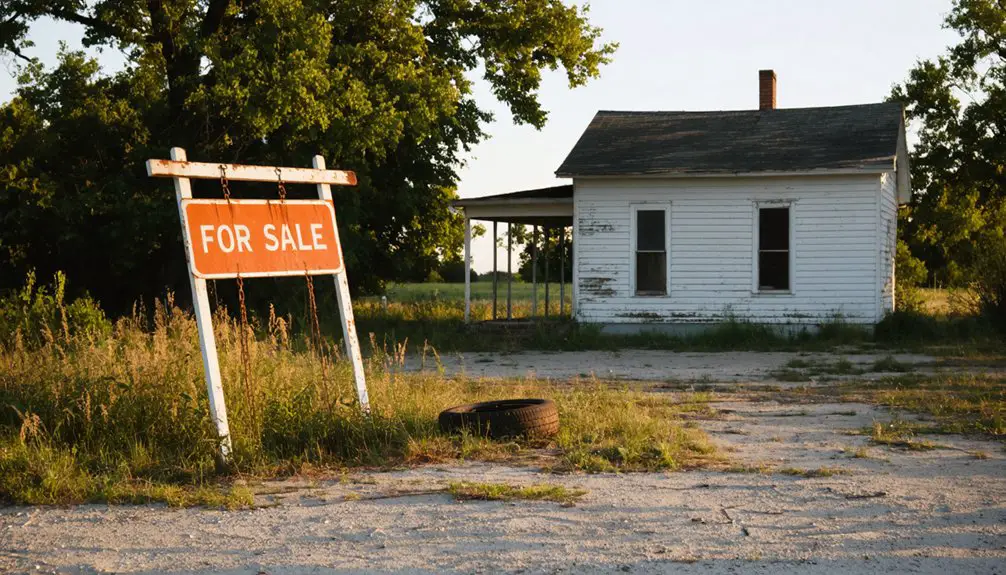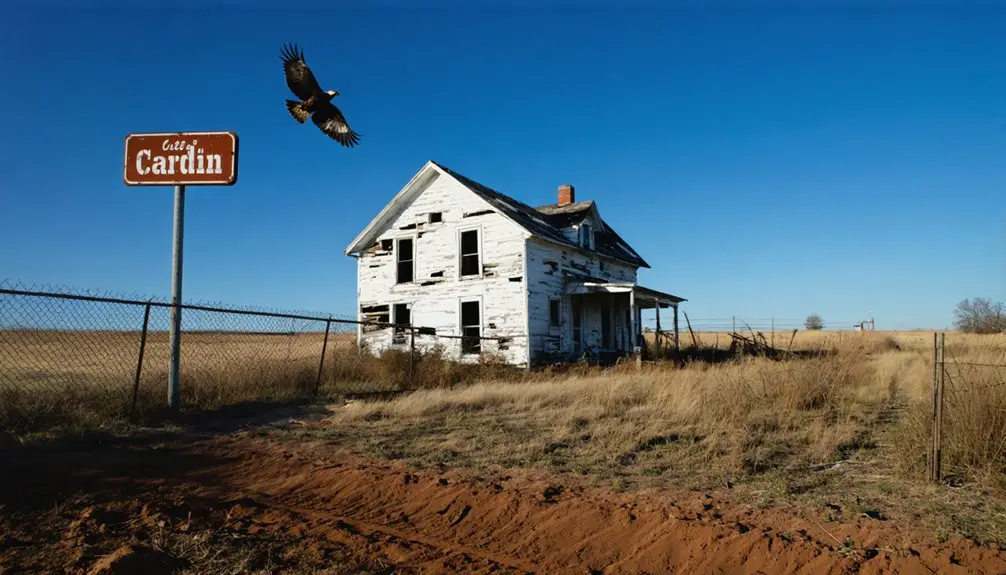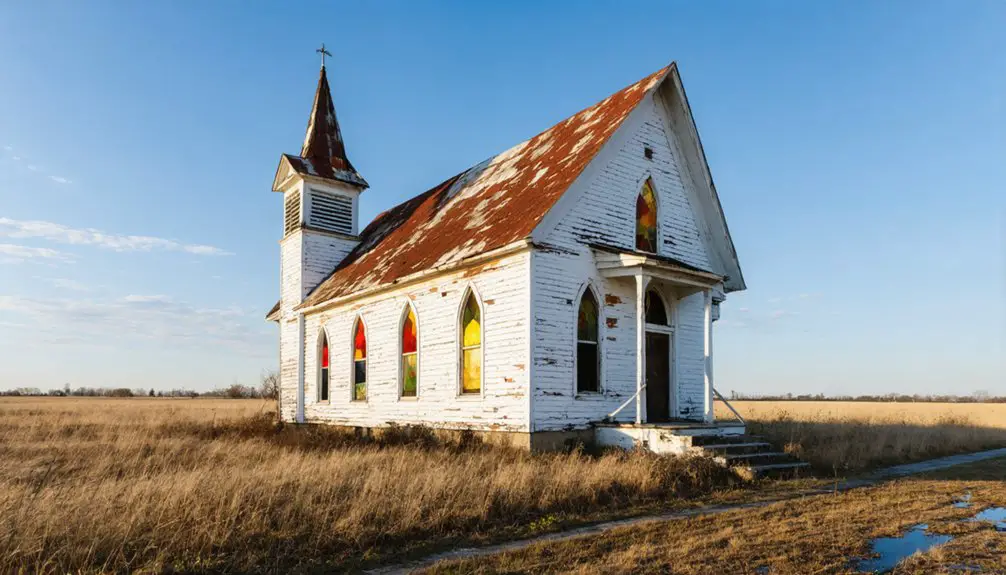You’ll discover one of Oklahoma’s most haunting ghost towns in Cardin, where toxic chat piles now loom over crumbling foundations. Once a thriving zinc mining hub with 2,640 residents in 1920, the town faced devastating environmental contamination that forced a federal buyout in the early 2000s. By 2010, the last residents had departed, leaving behind empty streets and scattered remnants of a community that produced over $1 billion in minerals. The town’s dark transformation from boomtown to toxic wasteland tells a cautionary tale about industrial progress.
Key Takeaways
- Cardin, Oklahoma became a ghost town by 2010 after a federal buyout program relocated residents due to severe toxic contamination.
- The town was once a thriving zinc mining hub with 2,640 residents in 1920 before environmental hazards forced its abandonment.
- Only abandoned buildings and toxic chat piles remain, making the area largely off-limits due to dangerous contamination levels.
- The town’s demise stemmed from extensive lead and zinc mining that created one of America’s most hazardous Superfund sites.
- The closure of Cardin’s post office in 2009 marked the end of all business operations in this former mining community.
The Rise of a Mining Boomtown
When lead and zinc deposits were discovered in the early 1900s, Cardin emerged as a vital hub within Oklahoma’s Tri-State Mining District.
You’d find this once-rural area quickly transformed into a bustling community, as mining techniques advanced and operations expanded throughout the region. The town’s strategic location near rich ore deposits in the Tar Creek area made it an essential player in what became the world’s largest zinc-producing region by 1915. Many workers relied on company store credit for their basic needs.
The economic impact was staggering – Cardin contributed to over $1 billion worth of minerals extracted between 1850-1950.
During a century of mining operations, Cardin’s mineral production helped generate over $1 billion in extracted resources.
As industrial and wartime demands for zinc and lead grew, you’d see the town flourish with new housing, businesses, and services to support the influx of miners and their families. The mining operations’ massive scale ultimately led to health complications from toxic dust exposure.
From Tar River to Cardin: A Name’s Legacy
If you’d visited this Oklahoma settlement before 1920, you’d have known it as Tar River, named for the nearby creek associated with lead and zinc mining deposits.
The town’s identity shifted when it was renamed after William Oscar Cardin, a prominent Quapaw Indian who owned the 40-acre townsite. Early settlers often carried place names from their homeland, as seen when the Taw River name was brought from Devonshire to the American colonies.
Through both names, you’ll find a rich historical narrative that connects the community’s natural resource heritage with its Native American roots. Similar to North Carolina’s history, the term “tar” was commonly used for naval stores colony operations.
Origin of Tar River
Long before mining transformed the landscape, two distinct springs marked the source of Tar Creek, seeping a black tar-like substance that gave the waterway its enduring name.
You’ll find this remarkable creek flowing southward for 18 miles until it meets the Neosho River, eventually reaching the sapphire waters of Grand Lake.
The black ooze that characterized Tar Creek came from natural mineral deposits surfacing through the springs, establishing a distinctive feature of the area’s natural heritage.
Originally, these lands belonged to the Quapaw Tribe, who maintained stewardship of the region before mining operations began.
The creek’s name stands as a symbol of the area’s original geological character, preserving the memory of a landscape that existed long before industrial development forever changed it.
By 1926, the region became the world’s largest producer of lead and zinc, forever altering the natural environment.
Today, the once-pristine waterway suffers from acidic mine water that has turned its waters blood red and decimated local wildlife.
Cardin Family’s Lasting Impact
The story of Cardin’s name carries deep roots in the region’s Indigenous heritage. When William Oscar Cardin, a Quapaw Indian, and his wife Isa Wade platted their 40-acre allotment in 1918, they established more than just a land claim – they created a legacy that would transform Tar River’s identity. Like the noble Portuguese origins of their surname, the Cardins established an enduring presence in Oklahoma.
You’ll find the Cardin heritage woven throughout the town’s peak years, as the community grew to 2,640 residents by 1920. By 1927, the once-bustling mining town saw its population dramatically decrease to around 400 residents.
The family’s influence bridged Indigenous identity with industrial development, creating a unique cultural footprint in northeastern Oklahoma’s mining district. Their name became synonymous with the area’s prosperous lead and zinc operations, while preserving an important connection to Native American land rights during a time of rapid economic expansion.
Evolution Through Two Names
Before becoming known as Cardin, this historic Oklahoma settlement carried the name Tar River, reflecting its connection to the nearby Tar Creek waterway.
You’ll find the name’s significance deeply rooted in the area’s natural resources, with historical variants like “Taw” or “Tor” appearing in early documents.
In 1920, the community embraced a new identity when it was renamed Cardin, honoring William Oscar Cardin and his wife Isa Wade of the Quapaw tribe.
This shift in community identity marked more than just a name change – it coincided with the town’s incorporation and celebrated its growth to 2,640 residents. The post office officially changed its designation on January 28, 1920.
The change from Tar River to Cardin represented a symbolic evolution from a resource-based identity to one honoring local leadership and indigenous heritage.
Environmental Crisis and Health Hazards
You’ll find Cardin’s devastating environmental legacy rooted in the toxic aftermath of lead and zinc mining, where massive chat piles and contaminated groundwater created one of America’s most hazardous Superfund sites.
The health impact on your community was severe, with 43% of local children suffering from elevated blood lead levels in the 1980s-90s, leading to neurological damage, learning disabilities, and other serious medical conditions.
Your town’s fate was sealed when federal officials initiated a $60 million buyout program, relocating residents away from the unlivable conditions created by decades of mining pollution. The area became part of an extensive cleanup effort where 329 acres of land were restored through Oklahoma’s remediation initiatives starting in 2005.
Toxic Mining Aftermath
Massive environmental devastation followed Cardin’s mining boom, leaving behind a toxic legacy of lead, zinc, and cadmium contamination that would eventually force all residents to abandon the town.
You’ll find vast piles of mining waste, known as chat piles, that continue releasing dangerous heavy metals into the soil, water, and air. These contaminants have destroyed local ecosystems and created serious health risks for anyone living in the area.
- Toxic dust from unstable chat piles spreads harmful metals throughout the region
- Groundwater and surface water pollution has devastated aquatic life in the Tar Creek watershed
- Elevated blood lead levels and chronic health issues plagued residents before their relocation
This environmental crisis led to increased pollution awareness and sparked extensive government cleanup efforts, though the land remains severely contaminated today.
Superfund Site Health Impact
The devastating health impacts of Cardin’s toxic mining legacy became apparent through extensive public health studies of the Superfund site.
You’ll find alarming evidence of elevated blood levels of lead, zinc, and manganese in local children, leading to learning disabilities and neurological damage. The community health crisis extends to higher rates of miscarriages, birth defects, and developmental disorders.
Multiple exposure pathways threaten residents, as toxic metals contaminate drinking water, soil, and air. Daily mine water discharge of up to 1 million gallons has poisoned local waterways for decades.
The health risks are particularly severe for children, whose developing organs are vulnerable to the complex mixture of mining contaminants. ATSDR assessments reveal cancer risks and chronic diseases that continue to burden this affected community.
The Final Exodus: Government Buyouts

During the early 2000s, federal officials launched an extensive $60 million buyout program targeting the lead-contaminated towns of Cardin, Picher, and Hockerville in Oklahoma’s Tar Creek Superfund site.
The buyout impact was swift and decisive, as the government offered residents fair compensation to relocate from areas plagued by toxic mining waste. Through the Lead-Impacted Communities Relocation Assistance Trust, the community relocation effort steadily emptied Cardin until its final residents departed in 2010.
- By 2009, only seven homes remained occupied before water services ended
- The post office’s closure in February 2009 marked the end of business operations
- Final buyout payments in November 2010 reduced the population to zero
This coordinated exodus freed residents from decades of environmental hazards, though it meant leaving behind their longtime home.
Remnants of a Lost Community
Walking through Cardin today, you’ll find only scattered remnants of what was once a vibrant Oklahoma mining town. The last business, a post office, closed in 2009, leaving behind crumbling foundations and partial walls that whisper community memories of busier times.
Like silent gravestones, abandoned buildings mark where a thriving mining community once stood, now reduced to crumbling ruins and fading memories.
You’ll notice one solitary church still standing, though its cemetery, like others, has largely vanished beneath mining spoils and debris.
The town’s historical significance is etched in the scarred landscape, where toxic lead and zinc mining waste now covers former homes and burial grounds.
Streets that once bustled with life now lead nowhere, their signs removed or rusted. Nature steadily reclaims the abandoned spaces where infrastructure has been dismantled, marking the end of a community forced to leave due to environmental hazards.
Notable Residents and Cultural Impact

Several prominent figures emerged from Cardin’s rich mining history, starting with William Oscar Cardin, the Quapaw Indian landowner who platted the original 40-acre townsite in 1918.
The town’s cultural heritage was shaped by historical figures who left lasting impressions on this once-bustling mining community.
- Merlyn Mantle, widow of baseball legend Mickey Mantle, was born here in 1932, connecting Cardin to America’s favorite pastime.
- Isa Wade Cardin, William’s wife, helped establish the town’s early foundations as a co-namesake and settler.
- Harry and Honey DePriest’s story exemplifies the town’s social dynamics, with their marriage representing the close-knit community ties.
These residents’ stories continue to preserve Cardin’s legacy, even as environmental challenges transformed it into a ghost town, serving as powerful reminders of its vibrant past.
Life After Abandonment: The Ghost Town Today
Since its complete abandonment in late 2010, Cardin has transformed into a stark reminder of environmental devastation‘s lasting impact on communities.
Today, you’ll find only ruins and urban decay where a small town of 150 residents once thrived just a decade earlier. Towering chat piles and toxic waste heaps dominate the landscape, while crumbling buildings stand as silent witnesses to the community memory of what once was.
The town’s 0.1 square miles remain largely off-limits, deemed unsafe for visitors due to persistent contamination and unstable ground conditions.
While EPA cleanup efforts continue throughout the broader Tar Creek Superfund site, Cardin itself stands frozen in time – a cautionary tale of industrial negligence and its irreversible effects on small-town America.
Frequently Asked Questions
What Happened to the School Buildings and Student Records From Cardin?
After housing over 2,600 students at its peak, your school buildings were demolished due to mining contamination, while your student records were safely transferred to Ottawa County or state education authorities.
Are There Any Annual Events or Reunions Held by Former Cardin Residents?
You won’t find any documented annual events or reunions specifically for former Cardin residents, though some may attend regional gatherings in nearby towns like Picher’s Christmas parade.
What Mining Companies Operated in Cardin During Its Peak Years?
Eagle-Picher Mining Company, you’ll find, dominated Cardin’s mining history as the principal producer, while Peoria Mining Land Company and several smaller mining and royalty companies shared company influence throughout the peak years.
Can Visitors Legally Explore the Cardin Ghost Town Site Today?
You can’t legally explore this site due to strict ghost town regulations and visitor safety concerns. It’s within a restricted Superfund area with active environmental hazards and government-controlled access.
Were There Any Attempts to Revitalize Cardin Before Its Final Abandonment?
Like a final heartbeat, you’ll find revitalization efforts existed when the town reincorporated in 1983 seeking government grants, but despite community support, environmental hazards and ground instability prevented any lasting recovery.
References
- https://okfronline.com/2020/01/cardin-okla/
- https://mamaloi.com/2011/07/15/cardin-oklahoma-ghost-town/
- https://en.wikipedia.org/wiki/Cardin
- https://allthatsinteresting.com/picher-oklahoma
- https://www.youtube.com/watch?v=FZJc5Ivk2J4
- https://www.okhistory.org/publications/enc/entry?entry=MI042
- https://nearbylens.com/cities/usa/ok/cardin/
- https://en.wikipedia.org/wiki/Tar_River
- https://digital.lib.ecu.edu/12604
- https://www.ghosttowns.com/states/ok/cardin.html



